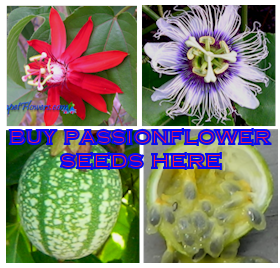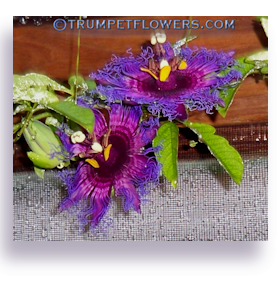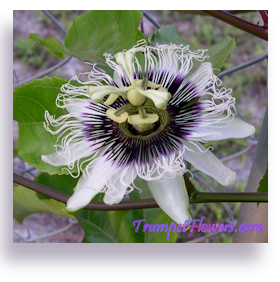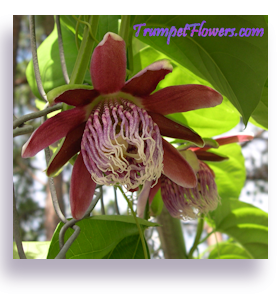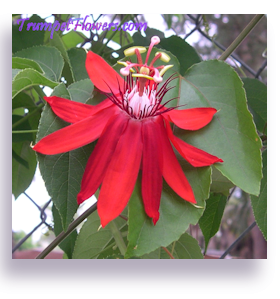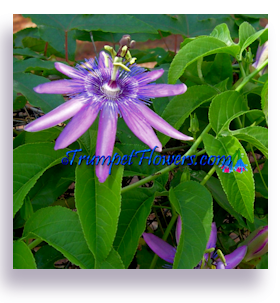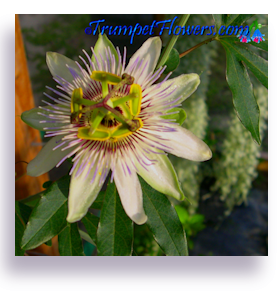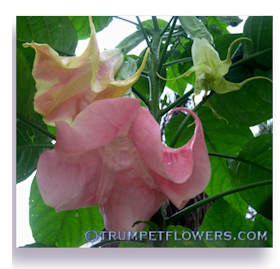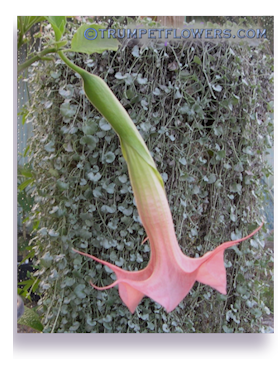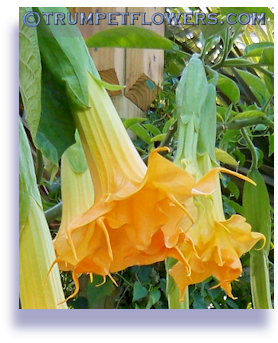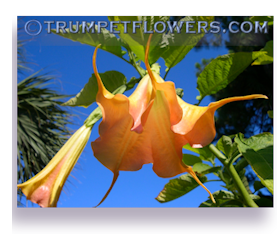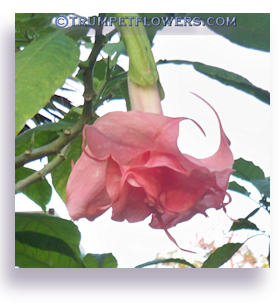Care and Grow
Passion Flower
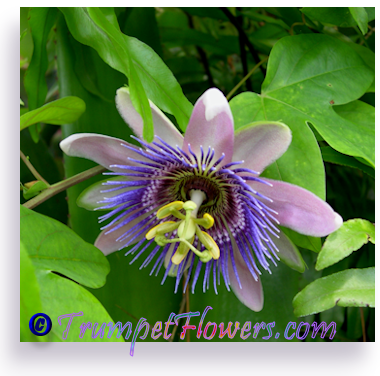 Passionflowers are in the top ten of one of the most spectacular vines that could grace a garden. The unusual and highly detailed flowers are real showstoppers. Most are fragrant, and attract a variety of bees, hummingbirds , moths and butterflies. Passiflora is highly used by Florida butterflies to use as larval food for their offspring, the caterpillars. So if you're looking for butterflies, grow some vines and don't pick off the caterpillars!
Passionflowers are in the top ten of one of the most spectacular vines that could grace a garden. The unusual and highly detailed flowers are real showstoppers. Most are fragrant, and attract a variety of bees, hummingbirds , moths and butterflies. Passiflora is highly used by Florida butterflies to use as larval food for their offspring, the caterpillars. So if you're looking for butterflies, grow some vines and don't pick off the caterpillars!
Passionflowers, for the most part, grow well in a partly sand, loamy soil. But from there it seems to vary (at least from my experience) as far as watering and amount of sunlight desired. Then it turns into a species or cultivar game.
 Passiflora incarnata, or the common maypop passionflower, seems to enjoy a mostly sandy soil and does well in full sun, and with very little fertilizer. It is invasive if left on it's own, so either mow regularly or plant it out in a large but shallow container, such as a windowbox, to keep it from creating underground runners that can be annoying to small gardens. It is one of the most hardy of passionflowers. Look it up in the Galleries above for more flower photos and leaf identification.
Passiflora incarnata, or the common maypop passionflower, seems to enjoy a mostly sandy soil and does well in full sun, and with very little fertilizer. It is invasive if left on it's own, so either mow regularly or plant it out in a large but shallow container, such as a windowbox, to keep it from creating underground runners that can be annoying to small gardens. It is one of the most hardy of passionflowers. Look it up in the Galleries above for more flower photos and leaf identification.
Passiflora morifolia does well for me in dappled sunlight with afternoon shade, and drinks more water than any passiflora I own. It enjoys fertilizer and frequent bouts of rainwater. The hairy leaves are grape∼like in appearance, and the tiny but lovely flowers grace this passion several times a year with steady care. Tiny purple fruits follow the flowers.
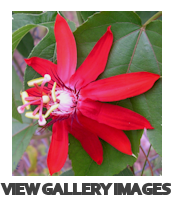 Passiflora vitifolia is also a bit more picky in the passiflora world. The plant loves a rich soil and benefits from time release fertilizer granules in early spring and again in summer. This passionflower is also called the Grape Leaf passion, and it lives up to the name with large, softly reddish green leaves that do remind one of grape. The bright red flowers appear several times a year, although the flushes do not seem to be as large in show as some other passions I grow. After a few years, the stems and roots will grow large and thick, and contrary to some information I've read on the internet, they will in fact reproduce by runners underground, albeit it takes years to see this phenomena.
Passiflora vitifolia is also a bit more picky in the passiflora world. The plant loves a rich soil and benefits from time release fertilizer granules in early spring and again in summer. This passionflower is also called the Grape Leaf passion, and it lives up to the name with large, softly reddish green leaves that do remind one of grape. The bright red flowers appear several times a year, although the flushes do not seem to be as large in show as some other passions I grow. After a few years, the stems and roots will grow large and thick, and contrary to some information I've read on the internet, they will in fact reproduce by runners underground, albeit it takes years to see this phenomena.
I have had passiflora vitifolia for about 10 years. It is not as aggressive as some others I keep, so is a good candidate for those of you who don't want to keep mowing over runners.
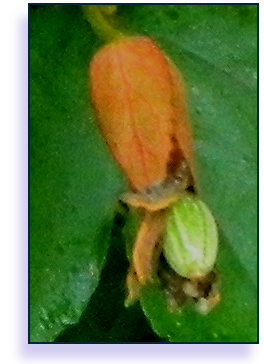 The Crimson Passionflower must be pollinated with a different cultivar in order to set fruit. I often cross it with passiflora edulis. The fruit is hard, but furry, a lovely watermelon striped coloration. I found out that the fruit must fall from the vine in order to have viable seed inside. To pick too soon (off the vine) and seeds will be white, no good for planting.
The Crimson Passionflower must be pollinated with a different cultivar in order to set fruit. I often cross it with passiflora edulis. The fruit is hard, but furry, a lovely watermelon striped coloration. I found out that the fruit must fall from the vine in order to have viable seed inside. To pick too soon (off the vine) and seeds will be white, no good for planting.
The Grape leafed passionflower will grow pretty easily from a cutting. Mine do best in partial shade with a mix of 3 hours dappled sunlight and about 3 hours strong sun. I don't have to water it all after it establishing, about 1 year. (Mine is in-ground)Takes an occasional light frost and bounces right back.
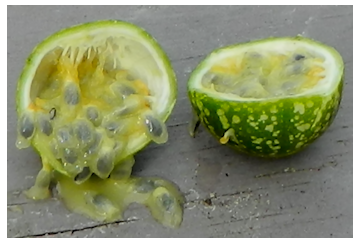 This is the same passion fruit from mother passiflora vitifolia as shown above, about 3 months later. It is ripe, as it detached from the vine. The rind is fairly hard to get through, but after slicing with a butcher knife, you can see the seeds and pulp. The pulp is tartly sweet, and delicious. The fruit itself is about 2 inches in diameter. There are others ripening that are larger, about 2 and a half inches across.
This is the same passion fruit from mother passiflora vitifolia as shown above, about 3 months later. It is ripe, as it detached from the vine. The rind is fairly hard to get through, but after slicing with a butcher knife, you can see the seeds and pulp. The pulp is tartly sweet, and delicious. The fruit itself is about 2 inches in diameter. There are others ripening that are larger, about 2 and a half inches across.
Passiflora Belotti is really beautiful, and reminds me of a glorified (if that is possible) Blue Crown passion. It too, loves a loamy, organic soil with sand and good drainage. I have found it to be one of the easier passionflowers to air∼layer. The fat and waxy blooms are sure to stun a garden visitor. I have had people see mine and think that they were fake. A geat passion to have in a collection. I give mine some protection from the harshest of sun, but more direct sun than morifolia. It blooms well in this garden condition.
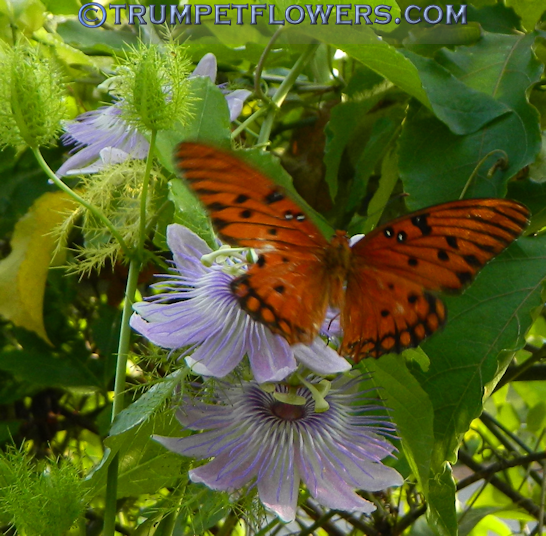
Passiflora Lavendar Lady has delicate, small leaves and lots and lots of blooms. A really nice passion to place on a long but not so high fence, if you are looking for complete coverage. Mine is on a 5 foot high fence, and grows straight to the top, and then spreads out horizontally about 40 feet, but only covering the top 2 feet of the 5 foot fence. Lavendar Lady is tolerant of sandy Florida soils with a fertilizer spike plunged into the earth at her main feet twice a year. She also likes good, strong sun and benefits from regular watering. Rains will set up huge bloom flushes that are really a sight to see.
Passiflora are really good vines for quick fence covering, if you are looking for privacy. The best I have seen for this use is Passiflora edulis.
Make sure you choose a spot that allows for climbing, passionflowers are notorious for this, and any tree within it's grasp will be folly to the twining vines.
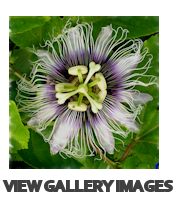 Passiflora edulis is one of the easier to grow passions, and in one season will cover an area of over 20 feet, up and down the 5 foot fence. Help it along by visiting the plant twice a week and hand forming the places you want it to fill on the fence. Within 3 years, the vine will have spread to over 40 feet and filled the entire heighth of the fence. Edulis benefits from a fertilizer spike twice a year, regular watering and full sun. It will also grow in partial shade, but flowers and fruits better with more sunlight. At least to my nose, it is also one of the more fragrant passions, and smells thickly of cotton candy or like sugar in a pastry shoppe. Look it up in the Galleries above, for flower and leaf identification.
Passiflora edulis is one of the easier to grow passions, and in one season will cover an area of over 20 feet, up and down the 5 foot fence. Help it along by visiting the plant twice a week and hand forming the places you want it to fill on the fence. Within 3 years, the vine will have spread to over 40 feet and filled the entire heighth of the fence. Edulis benefits from a fertilizer spike twice a year, regular watering and full sun. It will also grow in partial shade, but flowers and fruits better with more sunlight. At least to my nose, it is also one of the more fragrant passions, and smells thickly of cotton candy or like sugar in a pastry shoppe. Look it up in the Galleries above, for flower and leaf identification.
Blue Crown passionflower, or passiflora caerulea, is loved by bees and butterflies, often used for their larvae, the caterpillars. The flowers are lovely, but I find it just a bit harder to grow than some other passions I have. It does not seem to care for the bright Florida sun we get in summers. I therefore plant it in partial shade, protected from harsh afternoon sun that burns it. It blooms well if watered and fertilized on a regular basis. It does not seem to be so picky about it's soil conditions once established. Mine are in a half sand, half peat and compost blend. From there it has grown out into the regular, nutrient poor sandy soils Florida is so infamous for. It does OK in this situation, although I think the feeding of the mother root base helps along the rest of the plant. It does become invasive with age, another one to either place in a pot if you don't want runners, or mow frequently to control.
Passiflora Suberosa is also an excellent butterfly plant, and used by Gulf Fritallaries and Zebra Longwings to raise their caterpillars. Eggs are laid on p. suberosa by both species. Zebra longwings prefer shadier planted p. suberosa, while the Gulf frits choose p. suberosa that is planted in sunnier locales.
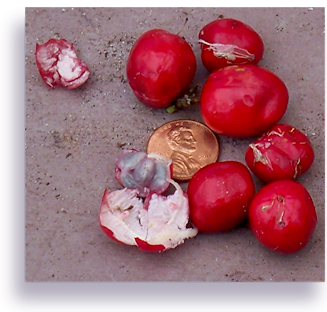 It is true what they say about growing passionflower from fresh seed. They will come up within a few weeks if you have fresh, and sometimes never if you don't. Being impatient, I have actually grown tired of waiting for seed to come up and recycled the soil for another plant, only to see the passiflora peek up a few months after that. By this point I don't know what passion it is until adult leaves begin to form.
It is true what they say about growing passionflower from fresh seed. They will come up within a few weeks if you have fresh, and sometimes never if you don't. Being impatient, I have actually grown tired of waiting for seed to come up and recycled the soil for another plant, only to see the passiflora peek up a few months after that. By this point I don't know what passion it is until adult leaves begin to form.
Grow passiflora seeds in a peat based compost and perlite mixture that has Osmocote fertilizer beads added to it. Barely place them under the soil, and keep them well watered, warm and give them abundant sunlight. Fresh seed should sprout within 3 to 8 weeks. Wait for them to get a couple of true leaves, and then begin to give a weakened fertilizer to encourage strong root growth.
The first few sets of leaves on passionflower do not have the adult leaf form. You'll have to wait until the vine is 10 inches or more in length, and then it will start to grow out the true leaves, which will resemble the species or cultivar.
 Almost every passionflora I have worked with does not like it's roots disturbed, and instead does well when they are crowded. If you do plan on repotting them, do so when rootbound, and give them a comparable, well loosened soil to sit in. Make sure to disturb the rootball as little as possible. Doing this on a cloudy, (or even rainy) day is beneficial to the plant. Just keep it slightly moist during the transplant time, allowing it to establish.
Almost every passionflora I have worked with does not like it's roots disturbed, and instead does well when they are crowded. If you do plan on repotting them, do so when rootbound, and give them a comparable, well loosened soil to sit in. Make sure to disturb the rootball as little as possible. Doing this on a cloudy, (or even rainy) day is beneficial to the plant. Just keep it slightly moist during the transplant time, allowing it to establish.
The one passiflora I have found that is an exception to this rule is passiflora edulis. It does not seem to care if you repot it, or even break up the rootball slightly. It recovers quickly from being moved from pot to pot, or pot to ground, and mine do not even wilt during this transition.
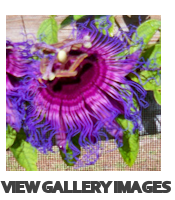 I also have passiflora cincinnata. It is typically a bit picky when first starting out, but after it becomes established it does very well. Mine seemed to be happier with the addition of some unmilled sphagnum moss to the Seed Starting Soil mixture I use for almost all of my passionflowers. It just bloomed for the first time on October 1st, 2012, and you can see them in the photo. If you'd like to see the leaves, look on this page Nutrient and Mineral Deficiencies & Solutions. There you will see pictures not only of the unusual leaves of this passion flower, which may help you in identification, but of an iron deficiency I am correcting. Another thing to note about this passion flower, is that the flowers remain wide open all day, not just partial and then shut before noon, like many do.
I also have passiflora cincinnata. It is typically a bit picky when first starting out, but after it becomes established it does very well. Mine seemed to be happier with the addition of some unmilled sphagnum moss to the Seed Starting Soil mixture I use for almost all of my passionflowers. It just bloomed for the first time on October 1st, 2012, and you can see them in the photo. If you'd like to see the leaves, look on this page Nutrient and Mineral Deficiencies & Solutions. There you will see pictures not only of the unusual leaves of this passion flower, which may help you in identification, but of an iron deficiency I am correcting. Another thing to note about this passion flower, is that the flowers remain wide open all day, not just partial and then shut before noon, like many do.
Passionflowers named above all withstand frost with protection. Remember, I am in zone 10A, so just throwing a sheet over them for the 3 or 4 nights that get below 32° here are perfect protection for mine. I do not cover the entire plant, just the main rootand stem system. This may cause the longer, exposed vine stems and leaves to brown, with the leaves falling off, but I never remove these. Instead, I wait for the warmth of spring before I do any pruning. Exposing a cut stem (usually hollow on passiflora) can allow in harmful fungi and other viruses that can injure the plant, so cutting in cold weather in a no∼no.
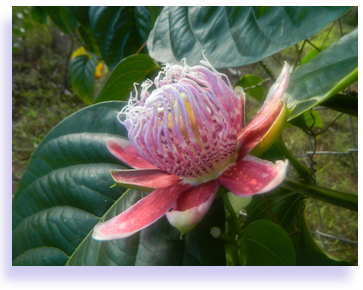 Speaking of pruning, it is good to prune the vines after they have attained some adult growth. This will encourage more flowering. Prune in spring, after the danger of frost has passed. The plant will quickly recover the areas it had been growing.
Speaking of pruning, it is good to prune the vines after they have attained some adult growth. This will encourage more flowering. Prune in spring, after the danger of frost has passed. The plant will quickly recover the areas it had been growing.
If you want to grow passion flowers for fruit, try incarnata and edulis. If you can find it, decasieana and ligularis are also very tasty. Incarnata is one passion fruit that will not appear as though it is ripe. Instead, a ripe fruit will remain green, but become heavier as it ages and ripens. You may have to test pick a few at various ages to get it just right. The seeds inside will be black when you have got it right. Other passion fruit will show their ripeness by beginning to wrinkle, become heavier, and fall. You can pick them right before they fall. If they do fall, pick up and use immediately.
Passionfruit is used as juice, in ice creams, cakes and pies, and even jellies. It is also eaten raw. Teas are often brewed from the flowers and leaves. My favorties for teas are p. edulis and p. incarnata.
Many passion flowers are identified through their leaf shapes. In the Passiflora Gallery in the top menu, you will be able to view the leaves of several of the species that I keep. This might help those of you who need to identify some of your unknown passion flowers.
Native passionflowers (Florida) are the maypop (Incarnata) yellow maypop, (lutea) passion vine (multiflora) and the corky stemmed passionflower, (suberosa). All of these passions are used by the butterflies Zebra Longwing (Fl. state butterfly) the Gulf Fritillary, and the Julia. Not only are they used as nectar sources for the adults, but the leaves are used as food sources for the larval caterpillars.
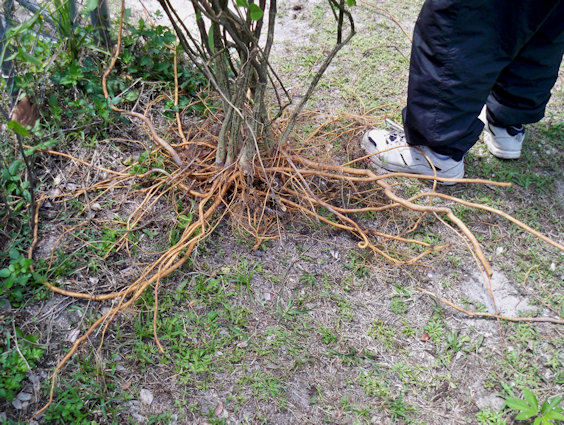
Digging up and moving a large and established passionflower can potentially kill it. Almost all passion flower vines hate their roots being disturbed. The only exception I have had success with is passiflora edulis and passiflora vitifolia. The commercial p. edulis was 5 years old in these photos.
Something very important to note, and the reason I took pictures, is that passionflowers naturally grow their root system by spreading outwards, just under the soil surface by a few inches. So digging one up is very tricky. You have to imagine the roots and how they spread out first, and dig accordingly. My husband kept the shovel about 3 feet away from the main trunk and then cut the long runner roots straight down with edge of shovel, freeing them. This was done to entire diameter surrounding the plant. Then he carefully dug underneath these roots, heading in towards the mother plant.
The main plant will contain some downwards supporting type roots. When reaching her, dig down about 2 feet on a plant this size. This should break it free.
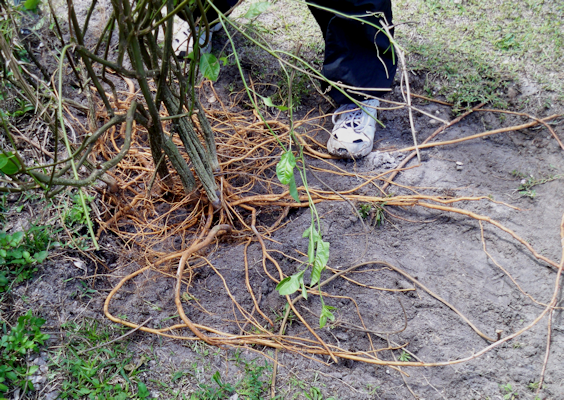
When replanting at main location, you will need to peel the soil surface the same 3 foot diameter, removing about 5 inches. Also dig the 2 foot hole where main trunk supporting roots will sit. Place the uprooted passion flower in the main hole and spread the runner roots out in the shallow cutaway. Place good, loamy and well draining soil overtop and tamp down with feet. Water it in well. We did two passionflowers using this method on very chilly, 45 degree mornings. The 30 foot passionflower vines had been cut to only about 3 feet in height. This way there should be less impact on the now shortened root system. We want the passionflower plant to build more roots and become established before putting out more top growth.
Remember to give the remaining top part of the plant good support while it reroots. This one was placed on chain link.
More about the care of Passion Flowers
Tags: passionflower,, grow passiflora, care and grow passion flower, passionflower care, care of passiflora, passionflowers, passiflora,
